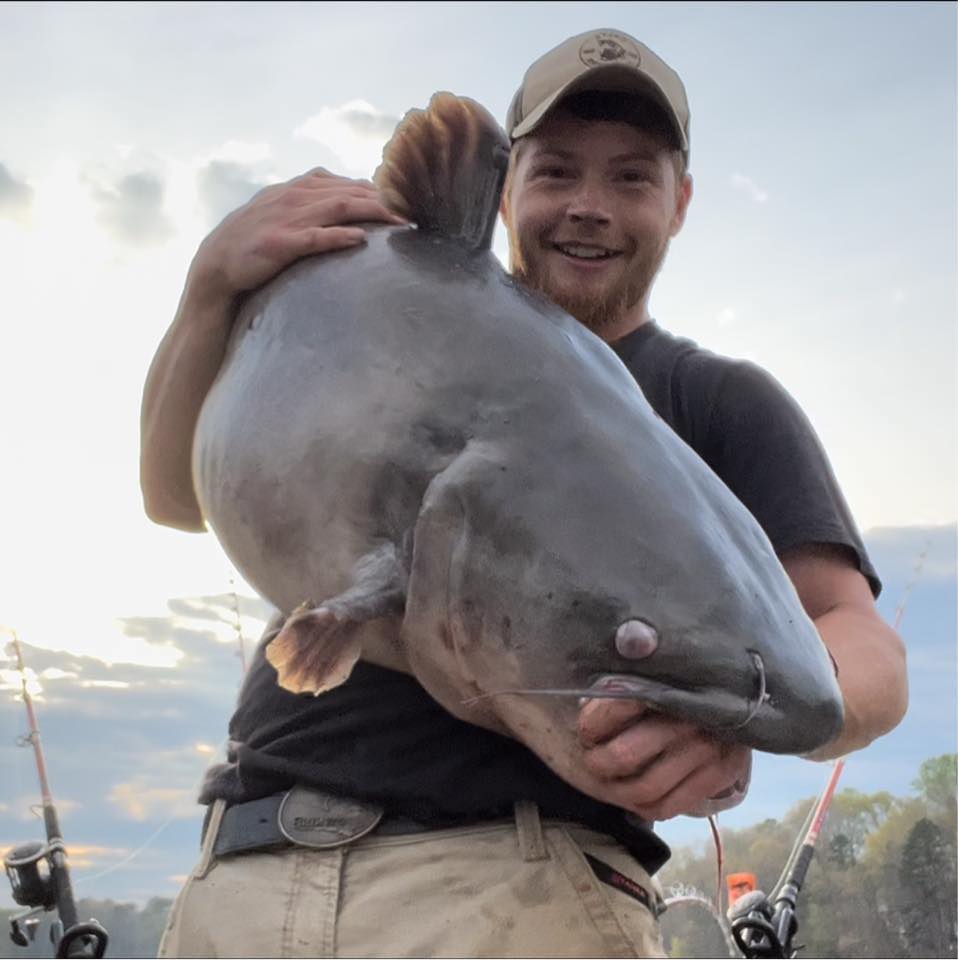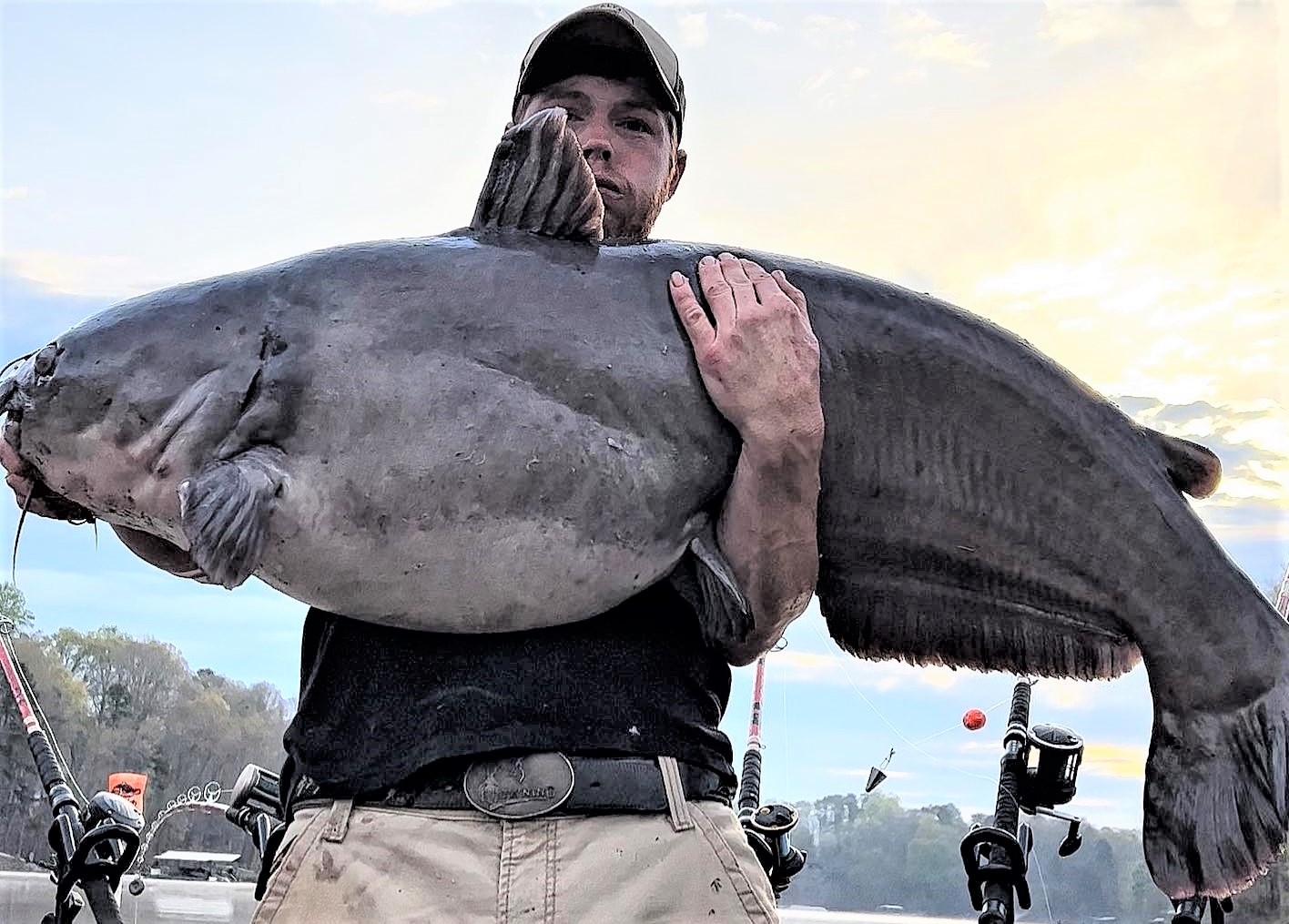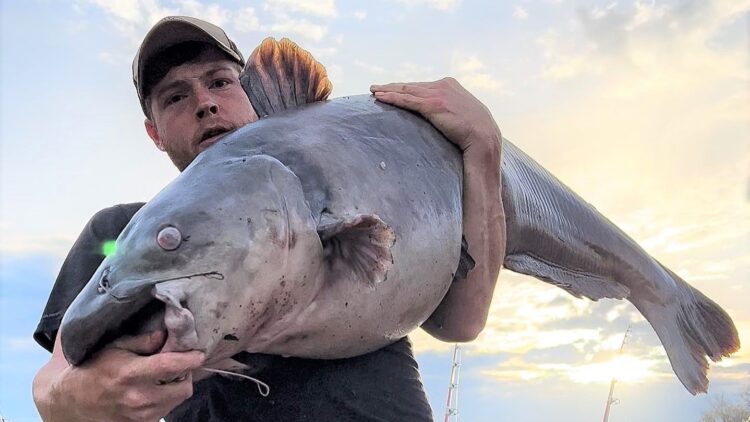Lake Hartwell Serves up Personal Best Blue Cat for Aaron Riggins
by Ron Presley
Lake Hartwell offers catfish anglers an excellent flathead fishery and plenty of big blues if you can get them out of the timber.
Lake Hartwell is a reservoir bordering Georgia and South Carolina. It offers anglers about 56,000 acres of water and 962 miles of shoreline to explore. The man-made impoundment has some extremely deep water and lots of timber. Hartwell Dam is on the Savannah River seven miles below where the Tugaloo and Seneca Rivers join to form it.
South Carolina resident Thomas Walker Jr. calls Lake Hartwell his home lake. He describes it as an exceptional flathead lake with 40- to 50-pound fish common while labeling it “mediocre” for blues, but with plenty of blues in that same size.
“There are plenty of 40- to 50-pound blues,” Walker said. “They are not caught that often due to the extreme timber-filled depths that the blues call home. They will venture out of the timber during the spring and winter that’s the best time to target them.”
Hartwell was never cleared before flooding so it is basically a submerged forest. Even the ruins of the abandoned town of Andersonville lie under the surface of the lake. The average depth is about 45 feet and the deepest is 185. Just about all types of catfishing can be accomplished on Hartwell, depending on the setting.
“You always have to adapt to conditions on Hartwell,” advised Walker. “Personally I have struggled a lot with suspend fishing but do great with anchoring. I also like to use the wind and floats to target certain structures.”
 Aaron Riggins is another local Hartwell angler. The Anderson, South Carolina catman recently showed what Lake Hartwell is capable of when it comes to blue cat fishing. Although he prefers fishing at night, on this day he set out early in the morning before the sun came up on what would be a most epic fishing adventure. Little did he know that he would catch his new personal best blue cat, two more trophy blues, and be heading for the ramp by 11:00 am.
Aaron Riggins is another local Hartwell angler. The Anderson, South Carolina catman recently showed what Lake Hartwell is capable of when it comes to blue cat fishing. Although he prefers fishing at night, on this day he set out early in the morning before the sun came up on what would be a most epic fishing adventure. Little did he know that he would catch his new personal best blue cat, two more trophy blues, and be heading for the ramp by 11:00 am.
“I knew I wanted to be somewhat shallow,” recalled Riggins as he described his morning of fishing. “I launched the boat in a creek and headed out. I moved along using my depth finder to scan as I went. I noticed that the water temperature rose the further back I went. I knew this was a good sign.”
Riggins continued in the creek to a spot where the water depth transitioned from consistently deep water (25-30 feet) to a shallow step up flat on one side of the channel that was about 20 feet deep. With no current to stabilize the boat he double anchored to set up and fish. He feels that double anchoring gives him an advantage by getting away from the bank to set up on ledges, points, or in this situation on a flat.
“I double anchor for a couple of different reasons,” explained Riggins. “Deploying an anchor out both the front and back of the boat gives me the proper rope distance to ensure that the boat stays in place and gives me a stable platform to fish from. Secondly, I double anchor to set up in the optimal location to hit a certain target. It also ensures that I can fish a widespread. I usually fan cast 6 to 8 rods in different depths and locations around the boat.”
On this day he positioned the boat in the middle of the creek which gave him optimal coverage to put the baits where they needed to be. He used a variety of live and cut bream that he caught the previous afternoon on a bait rod with red worms. His B’n’M rods were tied with float rigs complete with circle hooks and placed in SmackDown Rod Holders.
“Once I was set up, I sat back, relaxed, and enjoyed the sun coming up,” confirmed Riggins. “For the first hour, I was getting bite activity but no hookups. Since I was getting bites I decided to stay a while longer.”
By about 8:00 am Riggins was thinking he wanted to try dragging some baits so he could cover more water. He started reeling in his B’n’M poles to move. He had three rigs remaining in the water when one of the B’n’M Silver Cat Elite rods got bit. The line was screaming from the reel as the rod tip pointed toward the water.
 “I picked up the rod and the fish was steadily taking out line,” reported Riggins. “I quickly got my phone out and begin recording before getting back to the fight. The fish came across the back of my boat and thankfully swam over the anchor rope. I could not do anything with this fish. He plowed his way to the right side of my boat where I had some control. At least I thought I had control. Ultimately it took me over 10 minutes of battling this fish to get him in the boat.”
“I picked up the rod and the fish was steadily taking out line,” reported Riggins. “I quickly got my phone out and begin recording before getting back to the fight. The fish came across the back of my boat and thankfully swam over the anchor rope. I could not do anything with this fish. He plowed his way to the right side of my boat where I had some control. At least I thought I had control. Ultimately it took me over 10 minutes of battling this fish to get him in the boat.”
With the trophy blue cat in the boat, Riggins was pumped full of adrenaline as he let go with a Rick Flair type WOOOO! He followed that with a big loud shout, LET’S GO! He had just landed the biggest fish he had ever seen.
“I continue to get more video for pictures and of course to prove that I got him back in the water,” explained Riggins. “I revived him and he kicked off in seconds. I felt such adrenaline, it was unreal. I knew that everyone within a five-mile radius just heard me celebrate.”
Riggins was on top of the world and in the moment. All the hard work, time on the water, and skunked-out fishing trips finally paid off. He had boated his new personal best 74-pound blue cat. It is almost unheard of on Lake Hartwell to catch a fish of that size. Ironically he wasn’t finished yet.
“Then I decided to reel everything up and drag my way back out of the creek,” continued Riggins. “I set out four rods directly behind the boat and threw one rod out each side with planer boards.
About 100 yards after his drag began a 41-pound blue cat took off peeling line. After another 100 yards of steady dragging another Silver Cat went down and a 29-pound blue cat came to the boat.
“I couldn’t believe I hooked into more good fish,” concluded Riggins. “I ultimately ended my day with the 29-pounder and was on my way home around 11:00 am. It was a day I will never forget. I am grateful and blessed to have had the experience and hope to break my personal best again. Hopefully next time with a giant flathead!”



